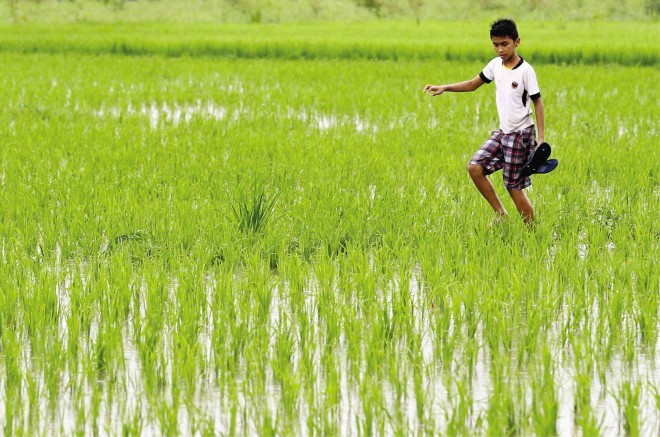
HAVING A FIELD DAY With classes suspended because of Tropical Storm “Kabayan,” this boy finds time to play in the flooded rice paddies of Barangay Tiaong in Guiguinto, Bulacan province, on Friday. Carefully keeping his slippers out of the water, he makes his way toward his playmates for a traditional game that involves throwing their slippers at a target. LYN RILLON
Tropical Storm “Kabayan” was expected to leave the Philippine area of responsibility around midnight Friday after dumping rains as it traversed Central Luzon, the weather bureau said.
Occasional rain will still be felt in the provinces of Pangasinan, Zambales and Bataan, according to the Philippine Atmospheric Geophysical and Astronomical Services Administration (Pagasa).
In its 5 p.m. weather update, Pagasa said Kabayan was last spotted 205 kilometers northwest of Dagupan City. It gained strength with a maximum sustained winds of 75 kilometers per hour near the center and gusts of up to 90 kph.
Metro Manila and the rest of Luzon will have cloudy skies with light to moderate rains as Kabayan moves west-northwest with a speed of 20 kph toward the West Philippine Sea.
Kabayan intensified from being a tropical depression and made landfall in Baler-San Luis, Aurora province, before dawn on Friday, crossing San Jose City in Nueva Ecija, before exiting landmass through Dagupan City, Pangasinan.
All public storm warning signals had been lifted but Pagasa warned that sea travel was still risky over the northern and western seaboards of Luzon.
But the military has still placed on alert its troops in Metro Manila as well as in northern and southern Luzon to brace for the effects of Kabayan as it makes its way out of the country.
A thousand troops from the Joint Task Force-National Capital Region (JTF-NCR), the Northern and Southern Luzon Commands are on standby for humanitarian assistance and disaster response missions.
“Our troops have been alerted to assist local authorities in mitigating the effects of the weather disturbance in these areas,” said Armed Forces of the Philippines public affairs office chief Col. Noel Detoyato.
He said troops not directly engaged in combat operations will be tapped for humanitarian assistance and disaster response missions should the need arise.
“Every division including the brigades and battalions have specially trained troops on standby during times of calamity,” the military official said.
He said the military has also readied chainsaws and other assets as well as heavy equipment available.
The JTF-NCR is also on hand to offer free rides for stranded passengers.
Meanwhile, authorities are searching for seven fishermen aboard four fishing boats that went missing after encountering rough seas on Thursday in Barnagay Pingit, Baler, in Aurora.
Elson Egarge of the provincial disaster risk reduction and management office said a total of nine boats went out at 6 p.m. that day.
Authorities were able to recover five fishing boats with 14 men aboard, while a search is being conducted to rescue the remaining missing four.
The National Disaster Risk Reduction Management Council (NDRRMC) raised its alert status to blue, placing half of its manpower on standby to monitor and disseminate advisories and warnings down to the regional and provincial levels.
The blue alert is the second highest alert level.
As of yesterday, 122 passengers, five vessels, three motorbancas and 53 rolling cargoes were stranded in Bicol ports due to rough sea conditions from the tropical storm.
In a report from the Central Luzon regional disaster risk reduction and management council, flash floods were monitored in Barangays Betania and Pinagbitangan in Laur, Nueva Ecija.
A landslide also occurred in Barangay Ligaya, Gabaldon in Nueva Ecija, prompting the evacuation of 30 families.
So far, 19 barangay in the towns of Laur, Cuyapo, Rizal and Bongabon in Nueva Ecija are submerged in floodwaters.
Five road sections were also impassable in Aurora, Bulacan and Nueva Ecija due to floods.
In Bulacan, rains dumped by Kabayan on Friday caused widespread floods which forced over 500 people from three villages in the towns of Bocaue and Sta. Maria to evacuate.
Floods also inundated a portion of the MacArthur Highway in Marilao town and raised the water levels of two dams in Bulacan—Bustos and Ipo—to their spilling levels.
The water level of Angat Dam, which supplies more than 90 percent of Metro Manila water needs, was 190.9 meters above sea level, far from its spilling level of 210 masl. With reports from Ron Lopez, Carmela Reyes-Estrope, and Tonette Orejas, Inquirer Central Luzon, and Gabriel Cardinoza and Yolanda Sotelo, Inquirer Northern Luzon

